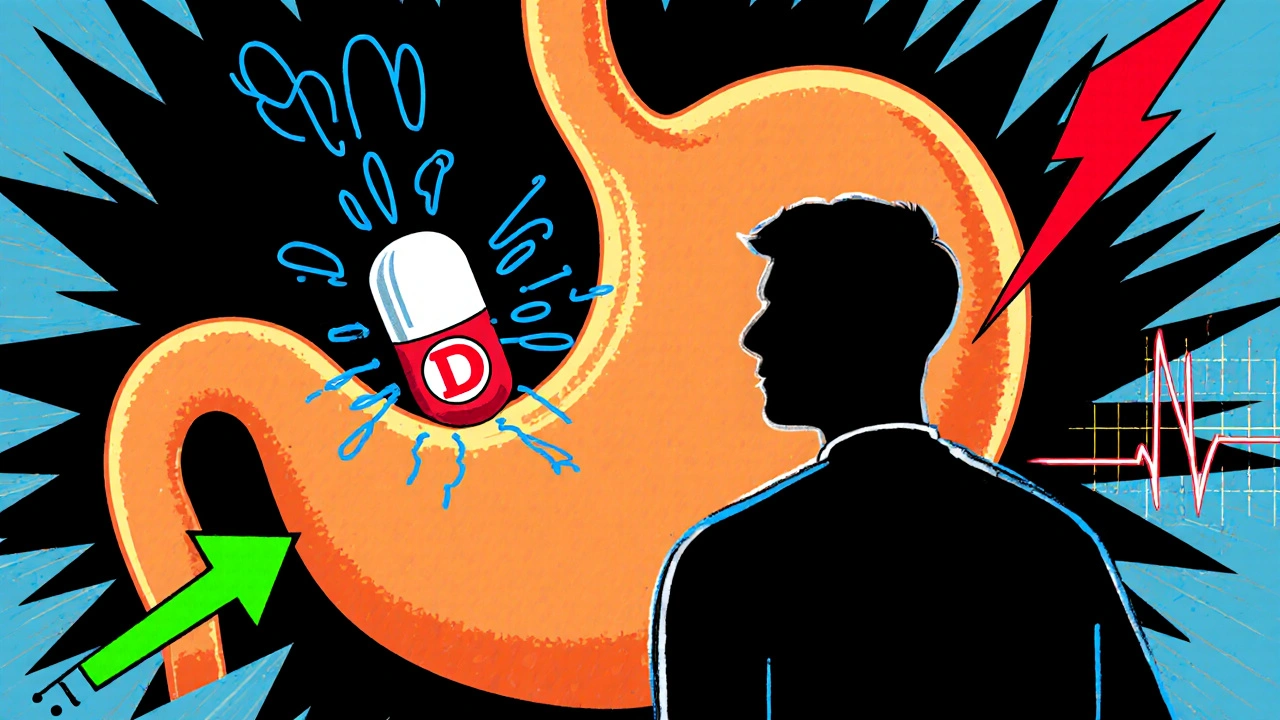
When dealing with Domperidone is a dopamine‑D2 receptor antagonist used to boost gastric motility and reduce nausea, many patients appreciate its ability to relieve symptoms without causing drowsiness. It works primarily in the gut, blocking dopamine signals that slow down the stomach’s muscular contractions. The result? Faster emptying, less reflux, and a calmer stomach.
However, the drug isn’t without drawbacks. Studies have linked high doses or prolonged use to QT prolongation, a change in heart rhythm that can lead to dangerous arrhythmias. Moreover, because it is metabolized by the liver enzyme CYP450 3A4, it can interact with a wide range of medications, from antifungals to certain antibiotics.

There are three main reasons patients consider switching:
If any of these sound familiar, it’s worth exploring the Domperidone alternatives that clinicians rely on.
| Drug | Mechanism | Typical Dose | Onset of Action | Key Side Effects | Regulatory Status (2025) |
|---|---|---|---|---|---|
| Metoclopramide | Dopamine‑D2 antagonist with 5‑HT4 agonist activity | 10mg orally before meals, up to 30mg/day | 30-60min | Drowsiness, extrapyramidal symptoms, rare tardive dyskinesia | Prescription‑only in US, OTC in some EU nations (low dose) |
| Ondansetron | 5‑HT3 receptor antagonist | 4-8mg PO/IV every 8h | 15-30min (IV), 1-2h (PO) | Constipation, headache, QT prolongation (high doses) | Prescription‑only globally |
| Itopride | Dopamine‑D2 antagonist + acetylcholinesterase inhibition | 50mg PO twice daily | 45-60min | Mild abdominal discomfort, rare liver enzyme elevation | Prescription‑only in Japan, limited availability elsewhere |
| Erythromycin (low‑dose) | Motilin receptor agonist (pro‑kinetic) | 250mg PO q.i.d. | 30-45min | Gastro‑intestinal upset, antibiotic resistance concerns | Prescription‑only; low‑dose used off‑label for motility |
The table above gives a quick snapshot, but choosing the right drug depends on your personal health profile.
Start with a simple decision tree:
Discuss these points with your doctor. A thorough medication review can reveal hidden risks, especially with polypharmacy in older adults.
Regardless of the alternative you pick, there are some universal tips:
Most side effects are reversible once the medication is stopped, but early detection makes the process painless.

Some OTC products, like chewable antacids with alginate, can reduce reflux symptoms but they don’t address delayed gastric emptying. If motility is the core issue, prescription‑only pro‑kinetics remain the most effective choice.
Metoclopramide doesn’t typically affect the QT interval, making it a safer option for patients with known cardiac conduction issues. However, it carries a risk of movement disorders, so regular neurologic checks are advised.
Clinical studies show that 250mg taken four times daily can improve gastric emptying in diabetic gastroparesis without exerting strong antibacterial pressure. It should be used short‑term (≤2weeks) to limit resistance.
Ginger, peppermint oil, and certain probiotic strains (e.g., Lactobacillus reuteri) have modest pro‑kinetic effects, but the evidence is far weaker than for pharmaceutical agents. They can be adjuncts, not replacements, for moderate symptoms.
Most guidelines recommend a trial of 4-6weeks for pro‑kinetic drugs. If symptoms persist, a gastroenterologist may suggest investigations like gastric emptying scintigraphy before extending therapy.
If you’ve identified a potential alternative, schedule a brief appointment with your prescriber. Bring a list of all current medicines, note any heart rhythm concerns, and be ready to discuss symptom patterns (e.g., after meals, at night). A shared decision‑making approach ensures you get relief without unnecessary risk.
Remember, each drug has a unique balance of benefits and drawbacks. By understanding the mechanisms, side‑effect profiles, and regulatory limits, you can make an informed switch that keeps your gut-and your heart-happy.
We must question why our health system lets a drug with heart risks stay on shelves while ignoring homegrown remedies that respect the body’s natural rhythm.
Our country deserves solutions that keep us strong 🌟💪. Switch to alternatives that are vetted by American research and we’ll stay ahead of the curve.
Why chase a new pro‑kinetic when the old ones work enough.
The very notion of swapping domperidone for any other agent forces us to confront the ethical underpinnings of pharmaceutical marketing.
Most of these alternatives are not born from altruistic science but from profit‑driven trials that prioritize market share over patient safety.
Metoclopramide, for instance, masquerades as a gentle dopamine antagonist while silently harboring the threat of tardive dyskinesia, a condition that can devastate quality of life.
Ondansetron, though praised for its anti‑nausea prowess, carries the hidden danger of QT prolongation at higher doses, echoing the very cardiac concerns we aim to evade.
Itopride may appear exotic, yet its dual action on dopamine and acetylcholinesterase does not exempt it from rare liver enzyme elevations that can evade routine labs.
Low‑dose erythromycin, a relic of antibiotic therapy, functions as a motilin agonist but feeds the ever‑growing problem of antimicrobial resistance, a societal burden we cannot ignore.
The moral calculus must therefore weigh immediate symptom relief against long‑term systemic repercussions.
Physicians should act as custodians of patient autonomy, presenting these trade‑offs without succumbing to the seductive language of pharmaceutical brochures.
Patients deserve transparent data on side‑effect prevalence, not merely a checklist of “common” adverse events.
Moreover, the regulatory landscape varies wildly, meaning a drug deemed safe in one jurisdiction may be restricted elsewhere due to undisclosed risks.
This disparity underscores the need for global collaboration in drug safety monitoring rather than isolated national silos.
When you consider that many of these pro‑kinetics interfere with CYP3A4 metabolism, the potential for dangerous drug‑drug interactions becomes glaringly apparent.
A holistic approach that incorporates dietary modifications, probiotics, and behavioral therapy can often reduce reliance on pharmacologic agents.
Ultimately, the decision to abandon domperidone should be rooted in a philosophy that values long‑term wellbeing over short‑term convenience 🌱✨.
In that spirit, we must champion evidence‑based alternatives while demanding accountability from the industries that profit from our discomfort.
Oh sure, just trust the big pharma’s “safe” label-because nothing ever goes wrong, right? 🙄
Imagine the gut as a stage where every meal is a performer waiting for its cue; when domperidone falters, the show collapses into chaos. I’ve watched patients stumble through dinner, their stomachs rebelling like an angry crowd, and the only applause comes from a pill that promises relief. The alternatives step into the spotlight, each with its own backstory-metoclopramide the brooding anti‑hero, ondansetron the cool, detached antagonist, erythromycin the veteran returning from war. Yet behind the curtain lies a script written by regulatory bodies that love red tape, and the audience-us-gets left guessing whether the next act will be a triumph or a tragedy. So, before you hand over your trust to another chemical understudy, ask yourself if the drama is worth the encore.
While many hail metoclopramide as the go‑to substitute, I can’t help but notice that its side‑effect profile often gets glossed over :) . It’s not just about nausea relief; we need to consider the risk of movement disorders that can sneak up after weeks of use. And let’s be honest, ondansetron’s cardiac warnings are not just footnotes-they’re real concerns for anyone with a predisposition. So before you jump on the bandwagon, take a moment to review your personal med list and discuss the subtleties with your doctor. A little skepticism can save you a lot of trouble later.
